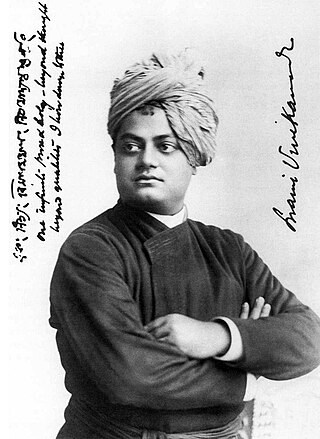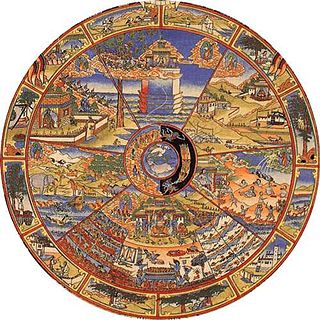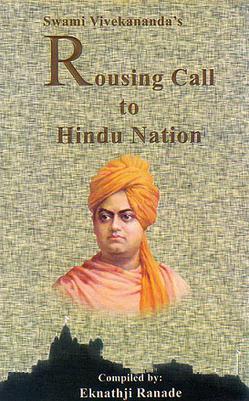
Swami Vivekananda, born Narendranath Datta, was an Indian Hindu monk, philosopher, author, religious teacher, and the chief disciple of the Indian mystic Ramakrishna. He was a key figure in the introduction of Vedanta and Yoga to the Western world, and the father of modern Indian nationalism who is credited with raising interfaith awareness and bringing Hinduism to the status of a major world religion.

Ramakrishna Math and Ramakrishna Mission (RKM) is a Hindu religious, spiritual and philanthropic organisation headquartered in Belur Math, West Bengal. The mission is named after the Indian Hindu spiritual guru and mystic Sri Ramakrishna Paramahamsa Deva. The mission was founded by Ramakrishna's chief disciple Swami Vivekananda on 1 May 1897. The organisation mainly propagates the Hindu philosophy of Vedanta–Advaita Vedanta and four yogic ideals – Jnana, Bhakti, Karma, and Raja yoga.

Shuddhananda who was the fifth president of the Ramakrishna Order, was a direct monastic disciple of Vivekananda. He joined the Ramakrishna Math in 1897. He became a trustee of Ramakrishna Math and a member of the governing body of Ramakrishna Mission in May 1903. He also took up the editorship of the Bengali magazine called Udbodhan for sometime. He was appointed as the secretary of the math and the mission in 1927 and as the vice president in 1937. In 1938, he became the president of the order. His tenure was short, as he died in 1938. He is renowned in the literary circles to have translated most of Vivekananda's original works from English to Bengali.

Swami Tapasyananda (1904-1991) was a senior monk of the Ramakrishna Mission. He was born in the Palat family of Ottapalam in Kerala, in 1904. His pre-monastic name was K. P. Balakrishnan Menon. In 1921, when he was just 17 years old, he met Swami Brahmananda- a direct disciple and spiritual son of Sri Ramakrishna, in Chennai. He received Mantra-Diksha from Swami Shivananda in 1924, and joined the Order in 1926, at 22 years age after completing in post graduation. In 1932, he received Sannyasa from Swami Shivananda. He was a disciple of Swami Shivananda, one of the eminent disciples of Sri Ramakrishna. The Swami was a vice-president of the Ramakrishna Order from 1985-1991, giving Mantra-Diksha to a large number of devotees. He was an erudite scholar in Indian and Western philosophy. He has to his credit many books in English, including the translations of many scriptures. His translation of Bhagavata Purana in four volumes has been highly acclaimed in intellectual and devotional circles. He was the president of Ramakrishna Math, Chennai from 1971-1991. Swamiji was well known for his austere life and intuitive intellect. His deity was Lord Khrishna and he practiced spiritual activity as told by his Guruji. He was a prolific writer. Some of the books authored by him are listed below. He translated many Hindu classics into English from original Sanskrit. He founded Ramakrishna Mission Hospital at Thiruvananthapuram.

Sister Nivedita was an Irish teacher, author, social activist, school founder and disciple of Swami Vivekananda. She spent her childhood and early youth in Ireland. She was engaged to marry a Welsh youth, but he died soon after their engagement.

Ramakrishna Math is the administrative legal organization of the Ramakrishna Order, considered part of the Hindu reform movements. It was set up by sanyasin disciples of Ramakrishna Paramhansa headed by Swami Vivekananda at Baranagar Math in Baranagar, a place near Calcutta, in 1886. India. The headquarters of Ramakrishna Math and its twin organisation, Ramakrishna Mission is at Belur Math.

Dasanami (IAST Daśanāmī Saṃpradāya "Tradition of Ten Names"), also known as the Order of Swamis, is a Hindu monastic tradition of "single-staff renunciation" generally associated with the four cardinal mathas of the Advaita Vedanta tradition and, according to tradition, organized in its present form by Vedic scholar and teacher Adi Shankaracharya.

Vedanta Societies refer to organizations, groups, or societies formed for the study, practice, and propagation of Vedanta, the culmination of Vedas. More specifically, they "comprise the American arm of the Indian Ramakrishna movement", and refer to branches of the Ramakrishna Order located outside India.

Abhayananda, born Marie Louise, was the first woman initiated into Vivekananda's mission. She was also the first American female and a female Westerner to have become a swami monk.

Inspired Talks is a book compiled from a series of lectures of Swami Vivekananda. From mid-June to early August 1895, Vivekananda conducted a series of private lectures to a group of selected disciples at Thousand Island Park. A number of lectures were recorded by Sara Ellen Waldo and she then published those as a book.

My Master is an English book combined from two lectures delivered by Swami Vivekananda in New York and England, published in 1901.

The Hymn of Samadhi or A Hymn of Samadhi was a song written by Swami Vivekananda. The song was originally written in Bengali as Nahi surjo, nahi jyoti or Pralay. Later the song was translated into English and was added into "The Complete Works of Swami Vivekananda" as The Hymn of Samadhi.
Hinduism in Los Angeles made its first significant impact in the late 19th century when wandering Hindu monk Swami Vivekananda, a disciple of Ramakrishna Paramahamsa, came on his second visit to the United States. Swami Paramananda, a disciple of Swami Vivekananda, founded the Vedanta centres in Los Angeles and Boston.

"My Play is Done" is a poem written by Swami Vivekananda. He wrote the poem in the Spring of 1895 in New York. In this poem, Vivekananda expressed his strong desire to return home. As he felt, the task of spreading his Master's message abroad was finally accomplished.

Nachuk Tahate Shyama,, is a Bengali language poem written by Vivekananda. The poem was originally published in two issues in Vivekodayam in 1904. The poem was later included in the second volume of The Complete Works of Swami Vivekananda. The long poem relates to one's surrender to the Hindu goddess Shyama or Kali, and is also interpreted as "Let Kali dance there" a poem dedicated to Kali.

Rousing Call to Hindu Nation or Swami Vivekananda's Rousing Call to Hindu Nation (1963) is a compilation of Indian Hindu monk Swami Vivekananda's writings and speeches edited by Eknath Ranade the leader of Rashtriya Swayamsevak Sangh. The book was published in 1963, in the birth centenary of Vivekananda. Ranade dedicated the book as a "personal homage to the great patriot-saint" Swami Vivekananda.

The relationship between Ramakrishna and Vivekananda began in November 1881, when they met at the house of Surendra Nath Mitra. Ramakrishna asked Narendranath to sing. Impressed by his singing talent, he invited him to Dakshineswar. Narendra accepted the invitation, and the meeting proved to be a turning point in the life of Narendranath. Initially Narendra did not accept Ramakrishna as his master and found him to be a "mono maniac", but eventually he became one of the closest people in his life. Ramakrishna reportedly shaped the personality of Narendranath and prepared him to dedicate his life to serve humanity. After the death of Ramakrishna, Narendra and his other monastic disciples established their first monastery at Baranagar.

Dhanraj Giri (1811–1901) was the abbot of Kailash Ashram, an ashram, which he established in 1880 at Muni Ki Reti, Rishikesh. It was one of the first large ashrams to be established in Rishikesh, prior to which it was mostly as a place for individual seekers, or pilgrims to stop over on way to Char Dham temples pilgrimage. He was a famous monk in Northern India and was a scholar in Vedanta philosophy. He was well acquainted with spiritual luminaries of nineteenth century India like Swami Vivekananda.
In 1888, Swami Vivekananda left the monastery as a Parivrâjaka— the Hindu religious life of a wandering monk, "without fixed abode, without ties, independent and strangers wherever they go". His sole possessions were a kamandalu, staff and his two favourite books: the Bhagavad Gita and The Imitation of Christ. Narendra travelled extensively in India for five years, visiting centres of learning and acquainting himself with diverse religious traditions and social patterns. He developed sympathy for the suffering and poverty of the people, and resolved to uplift the nation. Living primarily on bhiksha (alms), Swami Vivekananda travelled on foot and by railway. During his travels he met, and stayed with Indians from all religions and walks of life: scholars, dewans, rajas, Hindus, Muslims, Christians, paraiyars and government officials.
Sri Sarada Math is named after Sri Sarada Devi, the consort of Sri Ramakrishna, and founded on 2 December 1954. Built by a group of eight sadhavis, as per the instructions given by Swami Vivekananda, it serves as a monastic order for women. Headquartered at Dakshineshwar, Kolkata, the organisation has branch centres all over India, in Sri Lanka and Australia. The nuns of this order use the title "Pravrajika" before their ordained name, and are usually addressed as "Mataji" meaning 'revered mother'.

















